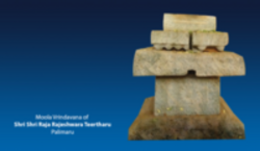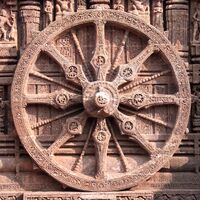Mangalaashtakam Verse 7:
वॆदाश्चॊपनिषद्गणाश्च विविधाः सांगाः पुराणान्विता
वॆदान्ता अपि मन्त्रतन्त्रसहितास्तर्काः स्मृतीनां गणाः
काव्यालन्कृतिनीतिनाटकयुताः शब्दाश्च नानाविधाः
श्रीविष्णॊर्गुणनामकीर्तनपराः कुर्वन्तु नॊ मन्गलम् ॥ ७ ॥
ವೇದಾಶ್ಚೋಪನಿಷದ್ಗಣಾಶ್ಚ ವಿವಿಧಾಃ ಸಾಂಗಾಃ ಪುರಾಣಾನ್ವಿತಾ
ವೇದಾನ್ತಾ ಅಪಿ ಮನ್ತ್ರತನ್ತ್ರಸಹಿತಾಸ್ತರ್ಕಾಃ ಸ್ಮೃತೀನಾಂ ಗಣಾಃ
ಕಾವ್ಯಾಲನ್ಕೃತಿನೀತಿನಾಟಕಯುತಾಃ ಶಬ್ದಾಶ್ಚ ನಾನಾವಿಧಾಃ
ಶ್ರೀವಿಷ್ಣೋರ್ಗುಣನಾಮಕೀರ್ತನಪರಾಃ ಕುರ್ವನ್ತು ನೋ ಮನ್ಗಲಮ್ || ೭ ||
vEdaashchOpaniShadgaNaashcha vividhaaH saaMgaaH puraaNaanvitaa
vEdaantaa api mantratantrasahitaastarkaaH smRutInaaM gaNaaH
kaavyaalankRutinItinaaTakayutaaH shabdaashcha naanaavidhaaH
shrIviShNOrguNanaamakIrtanaparaaH kurvantu nO mangalam || 7 ||
May the following varied types of sounds, always engrossed in extolling the qualities and names of the Lord, bless us with auspiciousness:
- Vedas, Upanishads and their components (known as vedaangaas)
- Puraana
- Vedaanta
- Mantra – tantra and associated Dialectical (Logic) texts
- Collection of Smritis
- Kaavya (poetry), alankaara (figures of speech), neeti (rules), naataka (dramas and plays)
Vedas: Vedas are Supreme amongst all literary forms known to mankind. They are considered to be eternal and un-authored from time immemorial; they are only “seen”, never composed or created. For this reason, they are supposed to be flawless and the best way of knowing about the Lord.
Fundamentally, there are only 3 vedas :
– Ruk (consisting mainly of poetic hymns),
– Yajus (mainly prose),
– Saama (musical hymns or melodies).
At the beginning of this Vaivasvata manvantara, Atharva muni propitiated Chaturmukha Brahma and with his blessings compiled the Atharva veda.
In the last dvaapara yuga (the 28th dvaapara in Vaivasvata manvantara) Lord Vedavyaasa segregated the vedas into 4 branches or shaakhas – Ruk shaakha consisting of Ruk Samhita, YajuH shaakha consisting of YajuH Samhita, Saama shaakha consisting of Saama Samhita and Atharva shaakha consisting of Atharva Samhita. He composed the 4 samhitaas and anointed 4 disciples to propagate the 4 shakhaas. These were Paila for Ruk Samhita, Vaishampaayana for YajuH Samhita, Jaimini for saama Samhita and Sumantu for Atharva Samhita.
Once, while coming down a narrow path in the Himalayas, Vaishampaayana inadvertently touched a boy coming in the opposite direction and caused him to fall to death in the ravines. Vaishampaayana came back to his ashrama and asked his disciples to perform penance on his behalf to resolve his brahma-hatyaa doshaa. The disciples started doing so. Yaagnyavalka was one of the disciples. He approached Vaishampaayana and humbly told him “Respected Guruji, why should all the disciples be troubled for this? Let me do it on everybody’s behalf and get rid of your dosha”. Vaishampaayana mistook this offer for arrogance and berated Yaagnyavalka and asked him to leave the ashrama. Yaagnyavalka left the ashrama and performed rigorous penance towards Soorya. Soorya was pleased with his efforts and blessed him with new vedic knowledge. This branch of Yajurveda is called Shukla Yajurveda since it came from the sun. The old portion with Vaishampaayana became known as Krishna Yajurveda.
Each Samhita was further developed into upa-shaakhas (branches). However, due to passage of time many of these upa-shaakhas have been lost and we are left with only a fraction of the original number. The table below lists the original number and what is available at present.
| Samhita | Original number | Available | Names of samhitas available |
| Ruk | 23 | 3 | Shaakala Samhita, baaShkala Samhita, saankhyaayana Samhita |
| S Yajuh | 15 | 2 | kaaNva Samhita, maadhyandina samhita |
| K Yajuh | 86 | 3 | Taittiri Samhita, kaTha Samhita, maitraayaNa Samhita |
| Saama | 1000 | 3 | Jaimineeya, raaNaayaneeya, kouthuma |
| Aatharva | 12 | 1 | Pippalaada samhita |
The total of the original number of upashaakaas = 24+15+86+1000+12 = 1137. When you add the digits 1+1+3+7 you get 12 which further becomes three. When you total what is remaining, that also ends up as 12 which becomes three. This is interesting because the Vedas are also called trayee (group of three).
Four-fold nature of the Vedas: Every veda has four aspects. The first is Samhita or Mantra bhaaga. The second is BraahmaNa, which describes the karma bhaaga (portion that prescribes actions to be taken) of the Samhita. The essence of BraahmaNa is AaraNyaka. The essence of the AaraNyaka is the Upanishad, which is also considered to be the quint-essence of the vedas.
- Samhita (Mantra bhagga) —- Studied during Brahmacharya
- BraahmaNa (karma bhaaga) —- Studied during Gruhasthaashrama
AaraNyaka (essence of BraahmaNa) —- Studied during vaanaprastha
- Upanishad
(quint-essence of vedas) —- Studied during sanyaasa
This is only a rough and general distribution; eligible, interested and meritorious people can study and practice any aspect during any phase.
Upanishad: Even though Upanishads are technically part of the Vedas they are generally reviewed separately because they contain quintessential philosophical truths about God and Creation. There are more than 100 upanishads, but 10 out of these are the most well known. Acharya Madhva has written commentaries on these 10 upanishads. These are listed below, along with the veda Samhita they come from.
- Ruk – mahaitareyOpanishat
- Saama – talavakaarOpanishat aka kenOpanishat
- Saama – ChandOgOpanishat
- Atharva – maandookOpanishat
- Atharva – aatharvaNOpanishat
- Atharva – ShatprashnOpanishat aka PrashnOpanishat
- K Yajur – taittireeyOpanishat
- K Yajur – kaaThakyOpanishat
- S Yajur (kaaNva paaTha) – yagneeyamantryOpanishat aka Ishaavaasya upanishat
- S Yajur (kaaNva paaTha) – bruhadaaraNyakOpanishat
Besides the above 10, some of the other Upanishads popular in shastra are MahaanaaraayaNOpanishat, naaraayaNOpanishat, shvEtaashvatarOpanishat, atharvashikOpanishat, kouSheetakyupanishat, mantrikOpanishat, agnirahasyOpanishat, subaalOpanishat, nRushimataapanyupanishat etc.
Vedangas: The Vedanga (literally “limbs of the Veda”) are six supplementary disciplines connected with the study of the Vedas. These are:
- Shiksha: phonetics, phonology, pronunciation.
- Vyakarana : grammar and linguistic analysis
- Nirukta : etymology, explanation of words
- Chandas : prosody – Focused on poetic meters
- Jyotisha : Astrology and Astronomy (finding the right time for performing any action)
- Kalpa : ritual instructions.
PuraaNas: These are ancient works composed by Lord Vedavyasa to supplement the study of vedas and understand their true import. Itihaasas are also ancient works that assist in the study of vedas. They are moola RaamaayaNa, Mahaabhaarata and Pancharaatra.
“Moola Ramayana” is the first Ramayana. It was composed by Lord Hayagriva and taught to Chaturmukha Brahma. It has 100 crore (1 billion) verses. Brahma taught this to Narada and Narada to Valmiki. Valmiki condensed it and presented it in twenty-four thousand Shlokas. There is a very popular verse that mentions this fact (“charitam raghunaathasya shatakOTi pravistaram ..”). However, nobody except Acharya Madhva talks about. This work, unfortunately, is not available to humans.
There are 18 Mahaa-puraaNas, all composed by Lord Vedavyasa, with many more smaller puraaNas known as upa-puraaNas. The names of the Mahaapuraanas along with their size (in terms of verses) and their classification (as saatvika, raajasika and taamasika) is listed below. This classification is given by a verse in the Padma puraana.
Saatvik puraanas – Number of verses
- Bhaagavata – 18000
- Vishnu – 23000
- Naaradeeya – 25000
- Garuda – 1900
- Varaaha – 24000
- Padma – 55000
Rajasika Purana – Number of verses
1. BrahmaanDa – 12000 2. Brahmavaivarta – 18000
3. MaarkanDeya – 9000
4. BhaviShya – 14500
5. Vaamana 10000 6. Braahma – 10000
Taamasika Puraana – Number of verses
1. Matsya -14000 2. Koorma – 17000
3. Linga – 11000
4. Shaiva (vaayu prOkta) – 24000
5. Skaanda – 81100 6. Agni – 15400
The upa-puraaNas are also supposed to be 18 in number but there is no unanimity about their names. The most popular upa-puraaNas are Nrusimha puraaNa, shivadharma puraaNa, saamba puraaNa, dEvi puraaNa (aka dEvi bhaagavata), soura Puraana .
Vedanta: The term “Vedanta” refers to works that reveal the true meaning of Vedas. There are many such works but the most prominent one is Brahma Sutra, composed by Lord Vedavyasa. This is considered to be the foundation of all theology and has commentaries by all three Achaaryas. Two other works that supplement the brahma sootra are dEva meemaamsa and karma meemaamsa. Unfortunately, these two are not available to humans.
The word ‘aagama’ is derived from the root ‘gam’ which indicates dynamism. If vedas are the science, Aagamas are the recipes for reaching the Lord. Some people interpret Aagama as something that “arrived” from God. Mantras and tantras are aspects of aagama. There are three types of aagamas – Shaiva, shaakta and vaiShNava. The crown jewel of all vaiShNava aagamas is Pancharaatra.
Tarka: “Tarka” refers to dialectical works that examine the veracity of statements based on logic. The most well known is Brahma-tarka, which is extant today. Other works like Acharya Madhva’s Anuvyaakhyaana, Jayateertha”s Nyaaya Sudha and Vyaasa teertha’s Nyaayamruta, Tarka taanDava and Chandrika are other examples in this category.
Smriti: Smriti (literally “that which is remembered”) are authored works, written to supplement knowledge encapsulated in the vedas. The traditional definition of Smriti includes the Vedaangas, Puraanas, Mahaabhaarata, Raamayana and other works. However, in this verse, it is used in a much narrower sense as the vedangas, puraaNas and tarka have been explicitly mentioned. Here, it simply refers to dharma shastra works written by sages like Manu, Parashara, etc. Old manuscripts refer to 20 smritis – Manu, Atri, ViShNu, Hareeta, Yaagnyavalkya, Ushanas, Angeeras, Yama, Aapastambha, Samvarta, Kaatyaayana, Bruhaspati, Paraashara, Vyaasa, Shankha, Likhita, Daksha, Goutama, Shaataapa and Vasha.
In addition to all the above works, Sri Raja Rajeshwara yati includes all forms of literature – Kaavya (poetry), Alankaara (poetic figure of speech), Neeti (rules), NaaTaka (dramas and plays). This is because of the fact that all words and sounds are basically epithets of the Lord and sing His praise.



